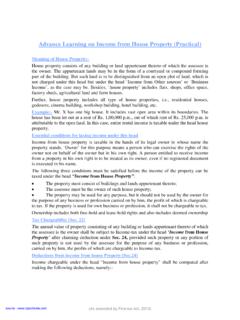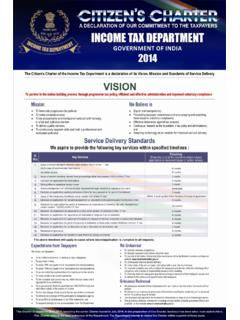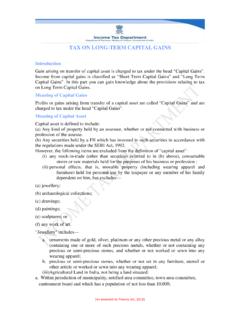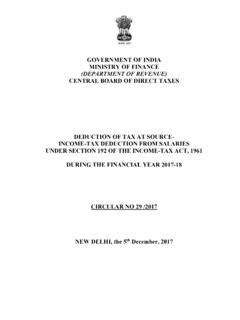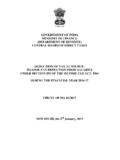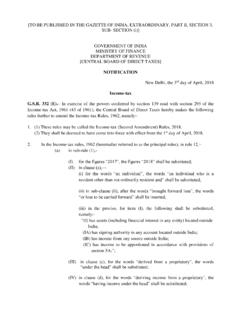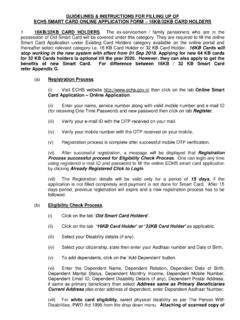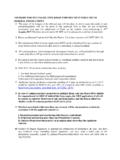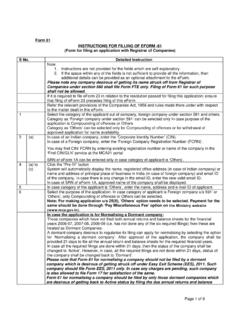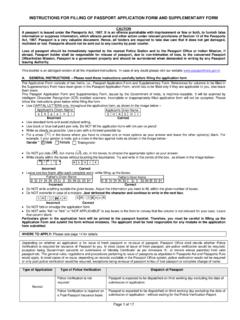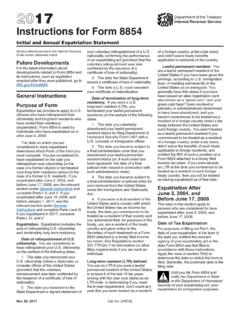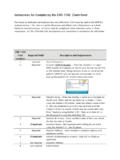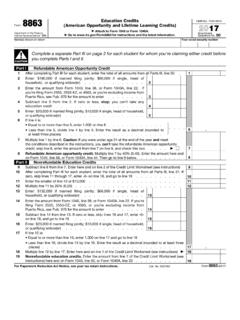Transcription of Instructions for filling ITR-1 SAHAJ A.Y. 2017-18 …
1 Instructions for filling ITR-1 SAHAJ 2017-18 General Instructions These Instructions are guidelines for filling the particulars in this Return form . In case of any doubt, please refer to relevant provisions of the Income-tax Act, 1961 and the Income-tax Rules, 1962. 1. Assessment Year for which this Return form is applicable This Return form is applicable for assessment year 2017-18 only, , it relates to income earned in Financial Year 2016-17. 2. Who can use this Return form This Return form is to be used by an individual whose total income for the assessment year 2017-18 includes:- (a) Income from Salary/ Pension; or (b) Income from One House Property (excluding cases where loss is brought forward from previous years); or (c) Income from Other Sources (excluding winning from lottery and income from Race Horses, Income taxable under section 115 BBDA or Income of the nature referred to in section 115 BBE) NOTE: Further, in a case where the income of another person like spouse, minor child, etc.
2 Is to be clubbed with the income of the assessee, this Return form can be used only if the income being clubbed falls into the above income categories. 3. Who cannot use this Return form This Return form should not be used by an individual whose total income for the assessment year 2017-18 exceeds lakh or includes,- (a) Income from more than one house property; or (b) Income from winnings from lottery or income from Race horses; or (c) Income taxable under section 115 BBDA; or (d) Income of the nature referred to in section 115 BBE; or (e) Income under the head Capital Gains , short-term capital gains or long-term capital gains from sale of house, plot, shares etc.; or (f) Agricultural income in excess of 5,000; or (g) Income from Business or Profession; or (h) Loss under the head Income from other sources ; or (i) Person claiming relief under section 90 and/or 91; or (j) Any resident having any asset (including financial interest in any entity) located outside India or signing authority in any account located outside India; or (k) Any resident having income from any source outside India.
3 4. Annexure-less Return form No document (including TDS certificate) should be attached to this Return form . All such documents enclosed with this Return form will be detached and returned to the person filing the return. 5. Manner of filing this Return form This Return form can be filed with the Income Tax Department in any of the following ways, - (i) by furnishing the return in a paper form ; (ii) by furnishing the return electronically under digital signature; (iii) by transmitting the data in the return electronically under electronic verification code; (iv) by transmitting the data in the return electronically and thereafter submitting the verification of the return in Return form ITR-V; NOTE: Where the Return form is furnished in the manner mentioned at 5(iv), the assessee should print out two copies of form ITR-V.
4 One copy of ITR-V, duly signed by the assessee, has to be sent by post to - Post Bag No. 1, Electronic City Office, Bengaluru 560 100, Karnataka. The other copy may be retained by the assessee for his record. Only the following persons have an option to file return in paper form :- (i) an individual of the age of 80 years or more at any time during the previous year; or (ii) an individual or HUF whose income does not exceed five lakh rupees and no refund is claimed in the return of income. 6. filling out the acknowledgment Only one copy of this Return form is required to be filed. Where the Return form is furnished in the manner mentioned at 5(i), the acknowledgment/ ITR-V should be duly filled. 7. Obligation to file return Every individual or HUF whose total income before allowing deductions under Chapter VI-A of the Income-tax Act, exceeds the maximum amount which is not chargeable to income-tax is obligated to furnish his return of income.
5 The deductions under Chapter VI-A are to be mentioned in Part C of this Return form . In case of any doubt, please refer to relevant provisions of the Act. The maximum amount not chargeable to income tax in case of different categories of individuals is as follows:- Sl. No. Category Amount (in ) (i) In case of individuals below the age of 60 years 2,50,000 (ii) In case of individuals, being resident in India, who are of the age of 60 years or more at any time during the financial year 2016-17 3,00,000 (iii) in case of individuals, being resident in India, who are of the age of 80 years or more at any time during the financial year 2016-17 5,00,000 Item by Item Instructions Part- A General Information Explanation Fill your Permanent Account Number.
6 Make sure that you fill your PAN Carefully. NOTE: In your PAN, first five and last one digit are alphabets and the remaining four digits are numerals. Fill your name as per details entered in PAN Card. Fill your 12 digit Aadhaar Number. In case, Aadhaar not allotted but applied for Aadhaar enter Aadhaar Enrolment Id. filling of the said field is mandatory Fill in your own Mobile number in the first 10 digits. Fill in your Email Address This is important for faster communication from/ with the department. Fill in the Communication Address NOTE: Flat/Door/Block No.; Name of Premises/Building/Village; Road/Street/Post Office; Area/locality; Town/City/District; State; Country. Pin code is mandatory. Tick mark the appropriate box for residential status. For non-residents certain deductions are not available (For more details, refer Income-tax Act, 1961) Tick mark the appropriate box if you belong to Govt.
7 , PSU or Others Tick mark the appropriate box: Voluntarily on or before the due date under section 139(1) 1 Voluntarily after the due date under section 139(4) 2 Revised return under section 139(5) 3 Under section 119(2)(b) on an application to be made separately before the Income-tax authority. (The return shall be treated as valid only after the application/ claim/relief under section 119(2)(b) has been admitted by the Income-tax Authority) 4 In response to notice under section 139(9) 5 In response to notice under section 142(1) 6 In response to notice under section 148 7 In response to notice under section 153A/ 153C 8 Provide the receipt number of Original return and Date of filing of Original Return.
8 It is mandatory for you to provide this detail in case of a revised /defective return, else the return will not be accepted by Income-tax Department. If the return is being filed in response to notice by the Income-tax Department under section 139(9)/142(1)/148/153A/153C provide the date of such notice. Exercise the option by ticking the box, if you are governed by Portuguese Civil Code and impacted by Section 5A of Income- tax Act, 1961. You should enter only your share of income in the column B2 (house property) and B3 (other sources). The balance share of income under these heads should be entered in the return of income of your spouse. If you are governed by Portuguese Civil Code and impacted by Section 5A of Income- tax Act, 1961 provide PAN of the Spouse Part-B Gross Total Income B1 Fill the details of salary/ pension as given in TDS certificate ( form 16) issued by the employer.
9 However, if the income has not been computed correctly in form , please make the correct computation and fill the same in this item. Further, in case there was more than one employer during the year, please furnish in this item the details in respect of total salaries from various employers. B2 If loss, mark the negative sign with in the brackets at left. Also tick the box as whether the house property is Self Occupied or Let Out . B3 Enter only if you have Income. If loss, please use ITR 2. B4 Add Items B1, B2, B3. If loss, mark the negative sign with in the brackets at left. However, this loss cannot be carried forward to next year using this form . Use ITR-2 for Carry Forward of Losses. Part-C Deductions and taxable total income - Some of the major items for deduction under this part are: 80C Amount paid or deposited towards life insurance, contribution to Provident Fund set up by the Government, recognised Provident Fund, contribution by the assessee to an approved superannuation fund, subscription to National Savings Certificates, tuition fees, payment/ repayment for purposes of purchase or construction of a residential house and many other investments (for full list, please refer to section 80C of the Income-tax Act).
10 As provided in section 80 CCE, aggregate amount of deduction under section 80C, 80 CCC and sub-section (1) of 80 CCD shall not exceed one lakh and fifty thousand rupees 80D Deduction in respect of Medical Insurance Premium, contributions to CGHS, medical expenditure Upper limit for 80D Deduction that can be claimed (A) Health Insurance Premium 1. Self , Spouse, Dependent Children (aggregate)- 25,000/- 2. Parents- 25,000/- 3. Senior Citizen or very Senior Citizen- 30,000/- 4. Premium paid by HUF for health insurance of any member of HUF- 25,000/- (B) Medical expenditure in the case of a very senior citizen (above 80 years) where no amount has been paid for his health insurance 1. On self- 30,000/- 2. On parents- 30,000/- 3. On member of HUF paid by HUF- 30,000/- NOTE: The aggregate deduction under (A1) and (B1) above shall not exceed 30,000/-, similarly the aggregate deduction (A2) and (B2) shall not exceed 30,000/.
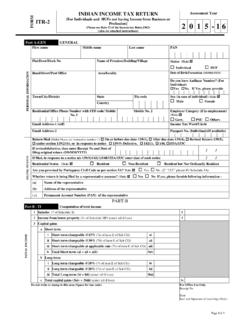
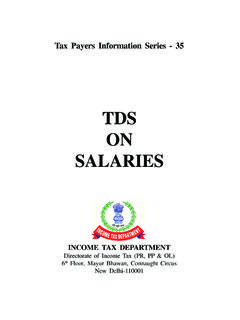
![FORM NO. 3CA [See rule 6G(1)(a)] Audit report …](/cache/preview/5/e/9/7/6/b/7/4/thumb-5e976b74d05a63207c471fc48a86f3e5.jpg)
